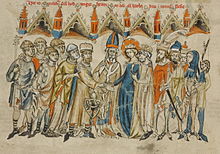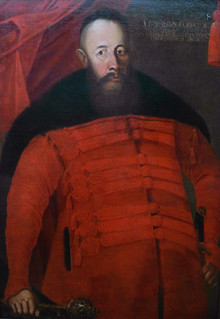User:Asank neo/sandbox
Polish halfshaven head(Polish: podgolony łeb, łaszczówka) - is a traditional polish noble haircut, associated mainly with sarmatism, but worn by Poles in Middle Ages too. It's maked by shaving hairs above the ears and on the neck on the same height, with longer hairs on the top of the head. For hundreds of years it was a typical of Poles.



History
[edit]Origins of halfshaven head aren't clear: today is impossible to say how many old it's. It was worn probably before the XII century to his slow disappareance in XVIII century. About "polish halfshaven head" in Middle Ages wrote f. ex. an anonymous franciscan from 1308 [1], Wincenty from Kielcza[2](half of XIII century), austrian poet Zygfryd Helbling(end of XIII century)[3] [4] swearing on polish and czech influences. In Chronicle of Mierzwa(beginning of XIV century) from Cracow we can also read that prince Leszek the Black(dead in 1288) grew his hair to ingratiate himself with Germans, so it was an scandal both in his times and in times of chronicle. In graphic sources there are paten(half of XIII century) from Płock cathedral founded by Konrad Mazowiecki, and the paten founded by Mieszko the Old(year 1195)[5] to the monaster of cistercians in Ląd, and floor from Wiślica(years 1175-1180) [6].
Halfshaven head and the other Slavs
[edit]It's posible that not only Poles, but also other Slavs worn a halfshaven head. British franscescan Bartholomeus Anglicus in year 1235 wrote in his encyclopedia, that mostly all the Slavs, exept Ruthenians and Slavs mixed with Germans and Latins, shave their heads[7]. Bartholomeus, who lived in Magdeburg from several years know good the slavic lands[8]. Slavic lands he understanded as area from Saxonia to Ruthenia and from Dalmatia, Carinthia and Serbia to the Baltic Sea. About shaven heads, and dislike to beards wrote also Saxo Grammaticus when writing about the temple of Arcona[9]. He write, that according to the common custom, only priests could grow long hairs and beards. [10] In a saxon manifesto against slavic pagans from year 1108 is mentioned that Slavs simulated Saxones during the attack by wearing their scalps[11].. Saxones grew long hairs[12], so polabian haircut have to be very different: very short. So, the custom of shaving hairs, in XIII century recognised as polish, have to have bigger dimensions. In old croatian tombs razors are often finded too, but the problem about dimensions of halfshaven head custom in other Slavic lands than Poland is still not investigated. [13]
See also
[edit]Sources
[edit]- ^ Anonymi descriptio Europeae Orientalis, wyd. O. Górka, Kraków 1916, s. 57-58: olim omnes Poloni ibant tonsi, sicut conversi cistercienses, sed nunc aliqui incipiunt dimittere crines.
- ^ Vita minor, cap. 24, MPH IV, s. 272: Ob cuius dispesacionis beneficium ac recordacionis memorabile signum indictum est Polonis, ut in tonsura rotunda conformarent se moribus religiosorum; to samo powtarza Vita maior, cap. 12, MPH IV, s382. Kontrowersje wokół datowania żywotów nie mają, według Jurka, znaczenia, gdyż dotyczą kilku lat, czyli około roku 1248 lub około 1254, zob. M. Plezia, Dookoła sprawy świętego Stanisława. Studium źródłoznawcze, wyd. 2, Bydgoszcz 1999, s. 138.
- ^ Seifrief Helbling, Der Kleine Lucidarius, III 225 n. Wyd. J. Seemüller, Halle 1886 (reprint 1987), s. 123: Waz will du Pôlân hôchbeschorn?/der Ungern waere daz vil zorn/ der ir langem hâr erkür/die hôhen pôlânischen schüer. Pieśń trzecia powstała, według ustaleń wydawcy (s. XX), w latach 1292-1294.
- ^ Ibidem, VIII 793n., s. 210 n.: und swer in disem lande snit/gewant nâch der Pôlân sit,/ daz dem sin hâr waer geschorn / hôch úf für die ôrn/ daz sold im nimer washen. Pieśń iVIII pochodzi z 1299 r.
- ^ Sztuka polska przedromańska, il. 1058; P Skubiszewski, Patena kaliska, Rocz. Hist. Szt. 3 (1962), s. 158-213; do datacji por. T. Jurek, Dokumenty fundacyjne opactwa w Lądzie, Rocz. Hist. 66 (2000), s. 34; barwna reprodukcja w: Cystersi w średniowiecznej Polsce. Kultura i sztuka. Katalog wystawy, Warszawa-Poznań 1991, s. 142-143, 146-147.
- ^ Sztuka polska przedromańska, il. 696, 703; L. Kalinowski, Romańska posadzka z rytami figuralnymi w krypcie kolegiaty wiślickiej, w: Odkrycia w Wiślicy. Rozprawy Zespołu Badań nad Polskim Średniowieczem Uniwersytetu Warszawskiego i Politechniki Warszawskiej, t. I, Warszawa 1963, s. 86-110; J. Leśny, w: SSS, t. VI, Wrocław 1980, s. 497-499 (z bibliografią); J. Dobosz, Polityka fundacyjna Kazimierza Sprawiedliwego, Poznań 1995, s. 54-57 (gdzie uściślenie ramowych dat powstania oraz zestawienie literatury).
- ^ A. E. Schönbach, Des Bartolomeus Anglicus Beschreibung Deutschlands gegen 1240, Mitteilungen des Instituts für österreichsche Geschichstforschung 27 (1906), s. 54-90, tu s. 71: qui omnes se intelligunt et in multis sunt similes, quo ad linguam et quo ad mores, dispares tamen quo ad ritum, – omnes etiam isti pro maiori parte in coma sunt attonsi, exeptis Ruthenis et ilis, qui mixti sunt cum Teutonicis et Latinis. Fragment tekstu z późnośredniowiecznego wyciągu wydał W. Kętrzyński w MPH VI, s. 587-588, zamiast attonsi dając jednak accensi (zapalczywi?).
- ^ Lexikon des Mittelalters, t. I kol. 1492-1493; por. Też A. F. Grabski, Polska w opiniach obcych X-XIII w., Warszawa 1964, s. 95 i n.
- ^ Saxo Grammaticus, Gesta Danorum, lib. XIV, cap. 39,3, wyd. J. Orlik, H. Raeder, t. I, Hauniae 1931, s. 645: Corrasae barbae, crines attonsi figurabatur, ut artificis industriam Rugianorum ritum in cultu capitum aemulatam putares.
- ^ Ibidem, cap. 39,4: sacerdos praeter communem patriae ritum barbae comaeque prolixitate spectandus.
- ^ Urkundenbuch des Erzstifts Magdeburg, wyd. F. Israel, Magdeburg 1937, nr. 193: Quamplures vivos excoriant et cute capitis abstracta hoc modo larvati in christianorum fines erumpunt et se christianos mentientes predas impune abigunt; przedruk: G. Labuda, Fragmenty dziejów Słowiańszczyzny Zachodniej, t. III, Poznań 1975, s. 233-236 (cytat s. 234); tamże obszerna dyskusja na temat tego zabytku. Na ustęp ten zwrócił uwagę S. Trawkowski, w: Kultura Polski średniowiecznej X-XIII w., s. 64.
- ^ Por. choćby u Widukinda lib. I cap. 9:mirati sunt Franci – diffusos scapulas caesarie [Saxones].
- ^ Cf. Maja Petrinec, Gräberfelder aus dem 8. bis 11. Jahrhundert im Gebiet des fruehmittelalterlichen kroatischen Staates, Split: Museum der kroatischen arcäologishen Denkmäler, 2009.; Vladimir Sokol, Hrvatska srednjovjekovna arheološka baština od Jadrana do Save, Zagreb: Cf. i Srednjovjekovni kostim na području stare hrvatske države, tekst kataloga Magdalena Dragičević, predgovor kataloga Vesna Čulinović-Konstatinović, autor fotografije Zlatko Sunko, Split: Muzej hrvatskih arheoloških spomenika, 1988.

